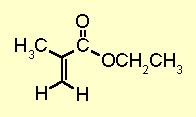Part 8: SPECTROSCOPY
The following data is available from the
question:
MS: M = 114 g/mol
(even, no isotope pattern for Cl
or Br)
EA:
Calculates empirical formula = C3H5O (IR confirms
O is present).
Which with MW from MS gives molecular formula = C6H10O2
. From here we get the IHD
= 2
IR:
There are significant absorptions at 1720cm-1 due to a
C=O
and at 1640cm-1
due to a C=C, C-O possible due to bands between
1200 and 1100cm-1. There is no OH (about 3500cm-1).
13C
nmr: The proton decoupled spectrum shows a total of 6 peaks
indicating
6 types of C. By analysis of the chemical shifts, we have a C=O
(probably
an acid derivative) at 167 ppm, 2 types in the region 125-140 ppm is
C=C,
61 ppm is typical of a C-O and those at 18 and 14 ppm are most likely
from
hydrocarbon portions.
1H
nmr: First of all we have 5 types of H showing up. After this,
it's a good idea to tabulate the information to make sure you get it
all
correctly matched up:
|
d/ppm
|
multiplicity
|
integration
|
Inference
|
|
6.1
|
"multiplet"
|
1
|
C=C-H |
|
5.5
|
"multiplet"
|
1
|
C=C-H |
|
4.2
|
quartet
|
2
|
CH2 coupled to 3H, deshielded by O ? |
|
1.9
|
singlet
|
3
|
CH3 with no adjacent H, slightly deshielded |
|
1.3
|
triplet
|
3
|
CH3 coupled to 2H |
The most significant structural
information in the H nmr data is that
we have an disubstituted alkene (note that the MW, MF, number of ArH
all
rule out the it being an benzene system), an ethyl group : -CH2-CH3
most
likely as an ethoxy group: -O-CH2-CH3 and an
isolated
methyl group : -CH3
Summary....
The MS indicated MW = 114 g/mol.
The IR showed the presence of C=O, C=C and C-O bonds.
13C peak at 167 ppm suggests that the C=O is a carboxylic acid
derivative
H nmr also gives a disubstituted alkene, a -O-CH2-CH3
and an uncoupled -CH3.
Use this to check the molecular formula : C6H10O2
= 6 x 12 + 10 x 1 + 2 x 16 = 114 g/mol
So with all this information we have the following pieces: C=O, -O-CH2-CH3,
-CH3 and H-C=C-H or H2C=C.
Altogether...
With the pieces we have : C=O, -O-CH2-CH3,
-CH3 and H-C=C-H or H2C=C.
IR and 13C suggest an ester so we have : CO2CH2-CH3
This means the two substituents on the alkene C=C are the ester group
and the -CH3
There are three possible arrangements: 1,1- , cis-1,2- or trans-1,2-
If it were 1,2- then the methyl group would have to have an H neighbour
and therefore appear as a doublet (i.e. in a CH3-CH=
system).
Therefore, it must be the 1,1-isomer where is has no adjacent H..... |

ethyl methacrylate
or
ethyl 2-methylpropenoate
|
The final step should always be to check
what you have drawn. The easiest
thing to check is usually the coupling patterns you would expect to
see,
and the chemical shifts of each unit.
You should be asking yourself : "Does my answer give me what the
H-nmr shows ?"
